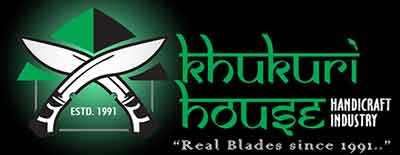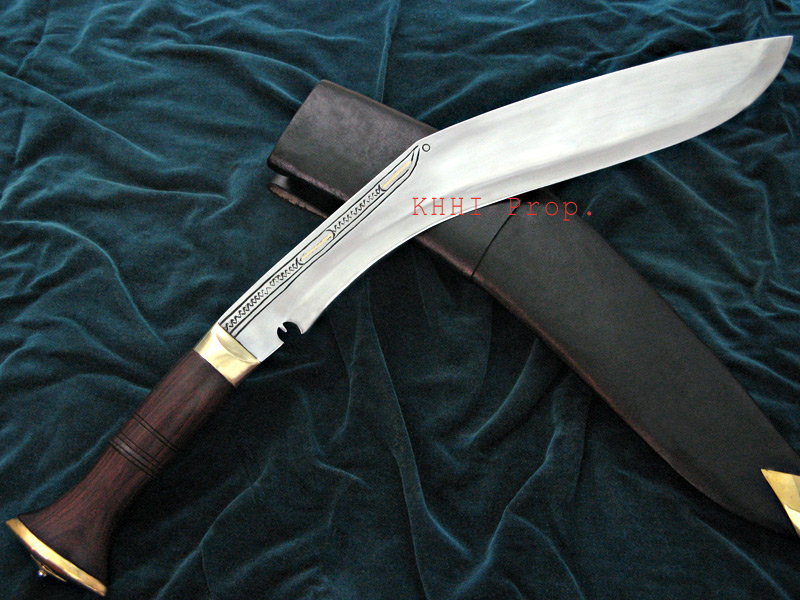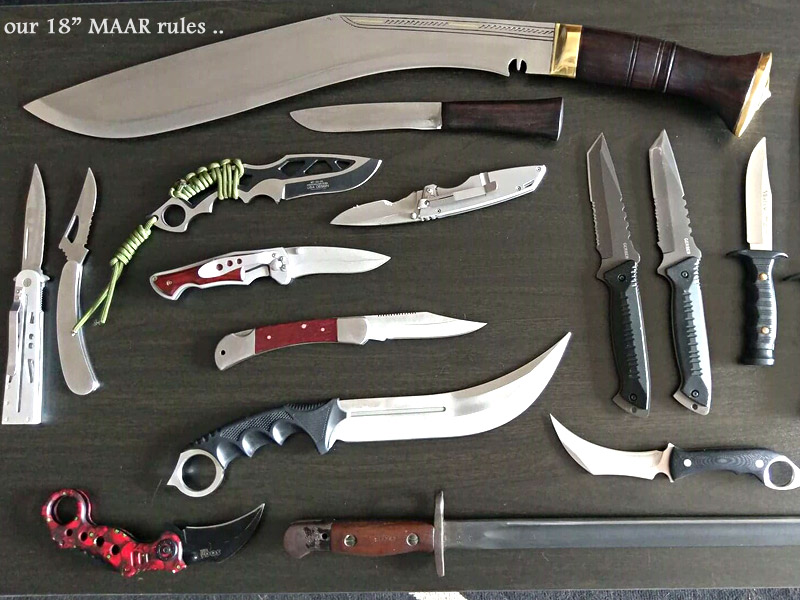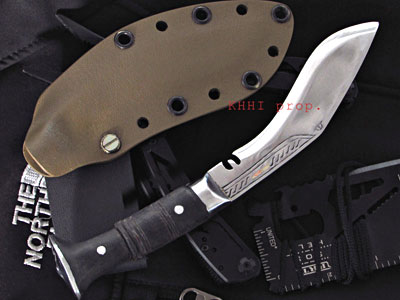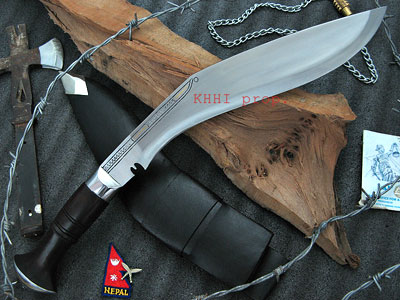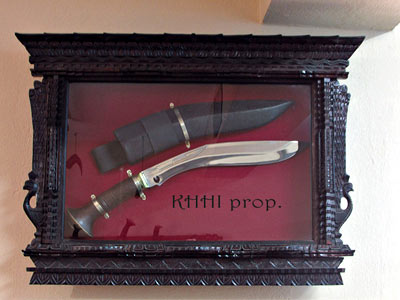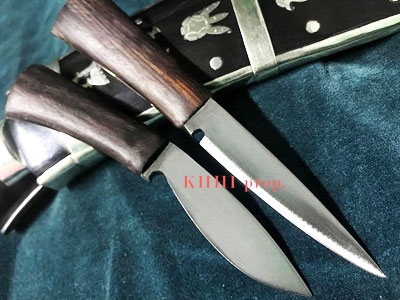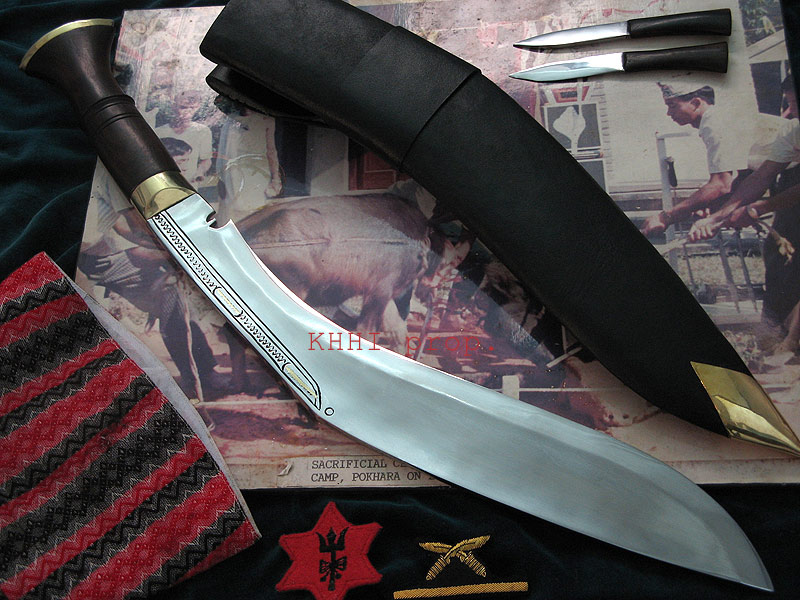
18inch Wooden (MAAR)
large khukuri with historic, religious value; a true sacrificial knife; also a no.1 combat khukuri of Gorkhali Soldiers during mid 1700’s..
Delivery: Estimated between May 18, 2024 and May 28, 2024
Item Location: Nepal
Default Specification
- Blade Size (in): 18
- Handle Size (in): 6.5
- Handle Material: Rosewood
- Blank weight (gm): 1000
- Actual Weight (gm): 1325
- Overall weight (gm): 1800
- Shipping weight (gm): 2300
- Blade finishing: Polished
- Blade sharpness: Standard (very sharp)
- Blade material: 5160
- Place of Origin: Dharan, Eastern Nepal
- Accompanying knives/B-up: Karda Chakmak
- Blade thickness (mm): 10
- Handle finishing: Polished
- Sheath: Water buffalo leather
- Tang type: Stick
- Fixture: Brass
- Edge grinding: Semi convex
- Edge Hardness: 55-57 hrc
- Blade (panel) Grinding: Full Flat
- Function: Sacrifical, Attacking, Heavy Duty, Gift, Lethal, Military, Combat, Show Piece, Collection
18inch Wooden (MAAR) sacrifical LARGE, machete kukri. Sometimes killing is the only way out..
religious value of MAAR kukri in Nepal >>
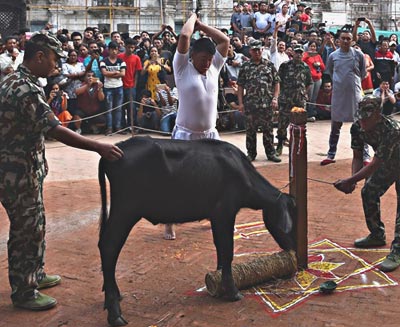 Most Nepalese are devoted Hindus. They have been practicing Hinduism since generations and ritual beliefs still go strong even today. Similarly it would be fair to say that the khukuri has also been contributing to all Nepalese to performing some of the religious act of Hinduism. One of the rituals and also traditions of Nepalese has a religious ceremony of beheading domestic animals as an offering to the goddess “Durgamata” during the main Nepalese festival, the “Dashain”. This is where the 18” khukuri chiefly comes into play, where it reveals its true identity, where it demands a kill and respect as a true slaughter power house.
Most Nepalese are devoted Hindus. They have been practicing Hinduism since generations and ritual beliefs still go strong even today. Similarly it would be fair to say that the khukuri has also been contributing to all Nepalese to performing some of the religious act of Hinduism. One of the rituals and also traditions of Nepalese has a religious ceremony of beheading domestic animals as an offering to the goddess “Durgamata” during the main Nepalese festival, the “Dashain”. This is where the 18” khukuri chiefly comes into play, where it reveals its true identity, where it demands a kill and respect as a true slaughter power house.
This is a large type of kukri used for sacrificing animals during festival, therefore the name 18” Marr (Sacrificial). “Dashain”, the main festival of Nepalese, which mostly falls in October is celebrated by sacrificing animals (buffaloes/goats) after necessary rituals are done on the 9th day called “Maar” during the 10th day long festival. It is a customary in Nepal that families celebrate the festival by purchasing domestic animal from locals and sacrificing it at home or mostly at temples as an offering to the goddess “Durgamata”. There is also a myth that the whole community where the ceremony is performed will suffer misfortune if the beheading is not done in one clean stroke. All the forging and making of the knife is done by hand using only conventional domestic tools. It takes three men a one whole day to finish this kukri.
Historic existence among 'Gorkhalis' ( mid 1700’s ) >> 18" MAAR is a modern version of the classic heavy kukris of the era..
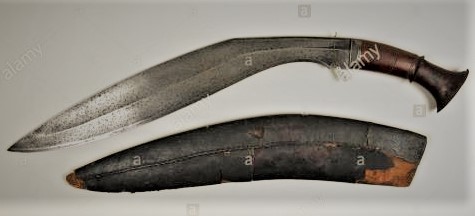
Historically speaking, 18” khukuri was primarily made for religious ceremonies and also as a no.1 combat khukuri for the soldiers. It was also made for the honorary and distinguished people to mark a deed or one’s position. The khukuri is believed to have existed centuries back but was only realized during the Gorkha campaign of uniting Nepal as one big country in mid 1700’s. The battles witnessed excessive use of large khukuris by Gorkhalis (Gorkha Army) which has also been documented and exhibited in the National Arsenal Museum in Kathmandu, Nepal.
The modern history of the 18” is however different. The khukuri because of its enormous size and not much of use for this modern techno world was in the verge of extinction. The importance and historical value was forgotten. It was just used in the festival just once in a year when the kukri really had to be used. It is only after the existence of KHHI, TB BK, the master craftsman, who started massively producing and promoting the khukuri the magnitude of it was once again recovered and realized. The massive production brought lower cost and intense promotion brought awareness and thus Nepalese once again got back their almost-gone pride.
"Maar" produced by KHHI (techncial aspects) >>
The blade measures 18” long and has a wooden handle thus the definite name. The shape resembles the “BhojPure” version; fat, thick and heavy. Brass fixtures are fitted in the handle to give a dashing look. The normal buffalo hide leather scabbard also has a protecting brass chape to give an overall matching look. 18” Wooden also comes with two accompanying knives in a considerable size, about 4 inches bladed; a good usable size.
18” wooden khukuri is also a good utility knife where heavy duty work of cutting is required. It works like a Machete; a perfect knife for hacking, chopping, clearing motherly things not possible from small or standard sized kukri knives. The wooden handle gives a traditional look. It also gives a strong and sturdy grip needed to execute big acts.
Additionally in current time this khukuri is frequently used as decorative piece due to its large catchy size.
Materials: Water buffalo leather scabbard, rosewood handle, 2 x accompanying knives
Origin: KHHI, Kathmandu, Nepal
